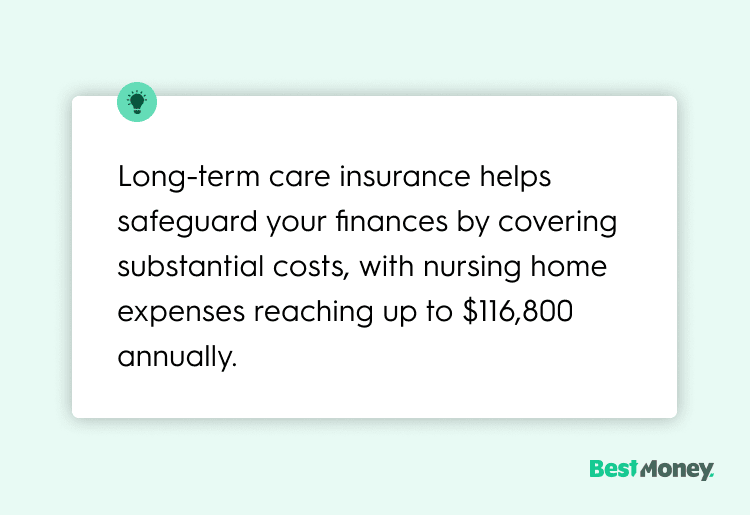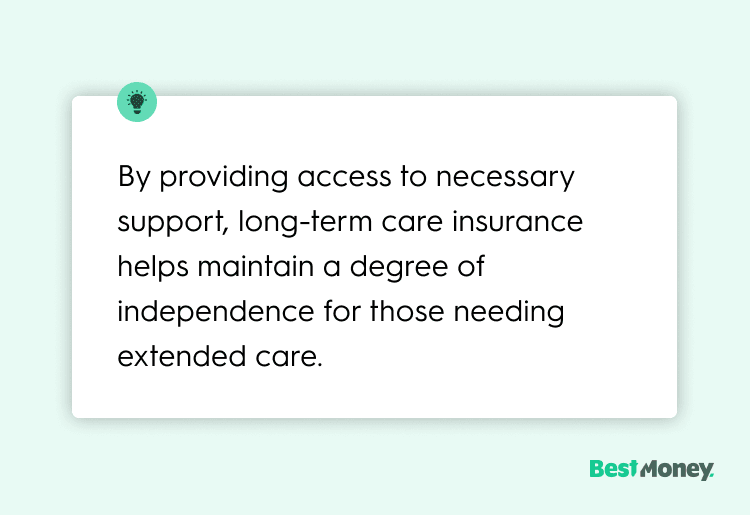
As healthcare costs rise, this insurance becomes increasingly crucial. Your coverage price can vary widely based on factors like the extent of coverage and daily benefit limits.
We'll explore key aspects of long-term care insurance and guide you in selecting suitable options from our best life insurance companies to protect your future well-being.
What Is Long-Term Care Insurance?
Long-term care insurance fills a crucial gap by covering expenses typically excluded from traditional health insurance or Medicare. These needs arise when individuals struggle to perform Activities of Daily Living (ADL) independently due to aging, chronic illness, or accidents.
Such assistance may be required for extended periods, often months or years. By providing access to necessary support, this insurance helps maintain a degree of independence for those needing long-term care.
How Does Long-Term Care Insurance Work?
Long-term care insurance policies cover personal or custodial care expenses in various settings. A medical professional determines eligibility, usually when someone needs help with Activities of Daily Living like transferring, bathing, dressing, toileting, or eating. The policy activates based on its specific terms.
These policies often include a long-term care insurance elimination period—a time when you'd pay for care out-of-pocket before benefits begin. This period typically lasts 30 to 90 days. Once benefits start, the policy may offer a fixed daily amount or reimburse actual care costs, depending on the services used. During this benefit phase, premium payments are generally waived.

What Factors Affect the Cost of Long-Term Care Insurance?
When considering long-term care insurance, several factors affect your policy's cost. Understanding these can help you make informed decisions. Consider using a life insurance calculator to estimate how much coverage you might need based on your circumstances and financial goals.
Age: Purchasing insurance earlier, typically between 50-60, can mean lower premiums. This age range often strikes a balance between affordable rates and timely coverage.
Gender: Women generally pay higher premiums due to longer life expectancy. This increased likelihood of needing care for an extended period impacts cost.
Health: Your medical history and current health status can significantly influence premiums or even eligibility. Maintaining good health can lead to more favorable rates.
Coverage: The daily benefit amount and length of coverage period you choose directly affect cost. Higher benefits and longer coverage increase premiums but provide more comprehensive protection.
Customization: Optional riders like inflation protection or international coverage allow policy tailoring but add to the cost. Consider which features are most important for your situation.
Location: Premiums reflect estimated care costs in your area. States or regions with higher living costs typically have higher insurance rates.
Remember, premiums vary between insurers, even for similar policies, so it's worth comparing options. These factors not only affect long-term care insurance but are also crucial when evaluating what senior citizens should consider when choosing a life insurance provider.
Average Cost of Long-Term Care Insurance in 2025
Long-term care insurance costs vary significantly based on factors like age, gender, health, coverage, and location. Understanding current and projected care costs can help you determine if this insurance fits your budget.
Mean daily care costs in the United States for 2023:
Home Health Aide: $207
Assisted Living Facility: $176
Skilled Nursing Facility (shared room): $285
Projected mean daily care costs for 2043:
Home Health Aide: $341
Assisted Living Facility: $318
Skilled Nursing Facility (shared room): $515
These 2043 projections by Genworth assume a 3% annual inflation rate. Comparing these figures with insurance premiums can help you assess the potential value of long-term care coverage over time.
How Can You Lower the Cost of Long-Term Care Insurance?
There are several ways to lower long-term care insurance premiums, including:
Buy Earlier: Purchasing coverage during your 50s or early 60s often results in lower premiums. The closer you are to potentially needing care, the higher the cost.
Adjust Elimination Period: Extending this period (the time you pay out-of-pocket before benefits kick in) can lower premiums. While 30 to 90 days is standard, opting for longer periods, like 180 days, may reduce costs.
Lower Daily Benefit Amounts: Choosing a smaller daily benefit can decrease premiums. Consider complementing this with personal savings to cover care costs.
Shared Benefits for Couples: Many insurers offer shared policies for couples, allowing access to a combined pool of benefits. This can allow for lower individual coverage and potentially reduced premiums.

What Are the Benefits of Long-Term Care Insurance?
Research from the Office of the Assistant Secretary for Planning and Evaluation (ASPE) reveals that 70% of adults reaching 65 will require significant long-term care support. However, only 48% receive paid care, largely due to cost concerns. This underscores the potential value of a long-term care policy. Here are three key benefits of having this insurance:
1. Financial Security: Traditional health insurance and Medicare typically don't cover long-term care, leaving you and your family to shoulder these expenses. Nursing home costs range from $285 to $320 per day, totaling $104,025 to $116,800 annually. These steep prices can rapidly deplete your savings. Long-term care insurance helps safeguard your finances by covering these substantial costs.
2. Freedom of Choice: While Medicaid can cover long-term care for those meeting strict income and asset requirements, it often limits your options. If you qualify, you're typically assigned care based on availability, not preference. Long-term care insurance, however, empowers you to choose where and how you receive care.
3. Reduced Burden on Caregivers: Long-term care insurance enables you to access professional care when needed. Without this coverage, family members often become primary caregivers, providing hands-on care themselves or funding it out-of-pocket.
What Are the Drawbacks of Long-Term Care Insurance?
While long-term care insurance offers many benefits, it's important to consider its potential downsides:
1. High Costs: Long-term care insurance premiums can be expensive, varying based on age, health, and gender. Without this coverage, you risk paying more out-of-pocket for care or receiving no benefits if you require minimal or no long-term support.
2. Limited Coverage Periods: Many policies cap payouts at three to five years. If you need care beyond this period, you may have to change facilities or pay out-of-pocket for continued support.
3. Complex Policies: Long-term care insurance contracts often contain intricate terms and conditions. Without thoroughly understanding these details, you might face unexpected limitations or exclusions when using the policy.
Who Should Consider Long-Term Care Insurance?
While most Americans will eventually need long-term care support, not everyone needs this insurance immediately. The "sweet spot" for purchasing is when you're young and healthy enough for lower premiums but not so far from potentially needing care that premiums outweigh benefits. Early planning is vital for future preparedness.
Consider long-term care insurance if you:
Have substantial assets to protect
Want to avoid burdening your family
Are in your early 50s (coupled) or 60s (single)
Enjoy generally good health
Desire for independence and control over future care

Bottom Line
Long-term care insurance is a valuable product for those who can afford it. Your premiums will vary widely based on factors like age, health, gender, coverage choices, and location. It's wise to compare options from different insurers to find a policy that meets your needs at the lowest cost.
This insurance helps protect your finances, maintain control over your care, and preserve your independence as you age. Most importantly, it offers peace of mind regarding future long-term care decisions.
» Ready to dive deeper? Explore our ultimate guide to life insurance for comprehensive coverage insights.



.20210802061955.svg)